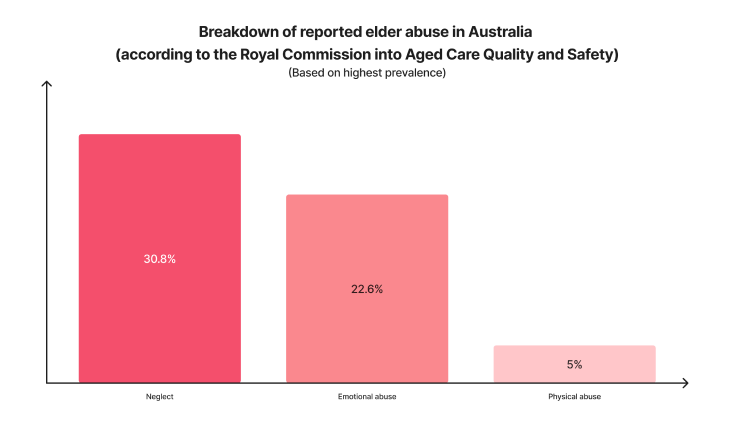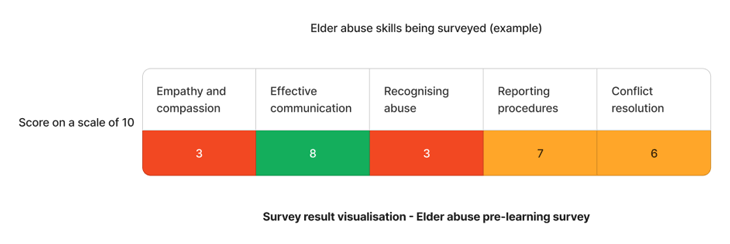This article is part of our Training Requirement Series, where we provide comprehensive guides to meet the actual training requirements that are often needed/requested of learning and development departments within Australia's healthcare organisations. This series includes both general requirements, such as elder abuse, but also focuses on the specific requirements stemming from the NDIS, Aged Care and NSQHS Quality Standards.
What is Elder Abuse?
Elder abuse is a deeply concerning issue within the healthcare sector, with profound implications for the well-being of elderly individuals. It encompasses various forms of harm or mistreatment inflicted upon older adults, often within healthcare organisations or caregiving environments. It's important to understand the different facets of elder abuse to develop effective prevention and intervention strategies.
Elder abuse can manifest in several ways:
- Physical Abuse: This involves the intentional use of force or physical harm, such as hitting, pushing, or restraining an elderly person. Signs of physical abuse may include unexplained bruises, fractures, or injuries.
- Emotional or Psychological Abuse: Emotional abuse entails the infliction of emotional distress or mental anguish on an older person. It can take the form of verbal insults, humiliation, intimidation, or isolation. Signs may include mood changes, withdrawal, or fearfulness.
- Financial Abuse: Financial exploitation occurs when an elderly individual's assets or resources are misappropriated or stolen. This can involve unauthorised access to bank accounts, coercion to change wills or property titles, or fraudulent financial transactions.
- Sexual Abuse: Sexual abuse comprises non-consensual sexual acts or inappropriate sexual behaviour toward an elderly person. Signs may include unexplained physical injuries, emotional distress, or changes in behaviour.
- Neglect: Neglect occurs when caregivers fail to provide the necessary care, attention, or support an elderly person requires. It can involve inadequate nutrition, hygiene, medical care, or basic necessities. Signs may include malnutrition, untreated medical conditions, or unsanitary living conditions.
Why is Elder Abuse Training Important?
According to the Royal Commission into Aged Care Quality and Safety (2020), the most prevalent reported forms of elder abuse were estimated to be neglect (experienced by 30.8% of people), followed by emotional abuse (22.6%) and physical abuse (5%).

What is the Elder Abuse Training Requirement?
Compliance with Aged Care Quality Standards necessitates a robust training program to address elder abuse effectively. Requirement 8.3 (d) (ii) specifically focuses on preventing elder abuse by enhancing staff knowledge and skills in identifying and preventing such incidents. It is to understand the requirements in order to stay compliant.
Relevant Standards
Requirement 8.3 (d): Risk management systems and practices to:
- (ii) Identify and respond to abuse and neglect
Systems are in place to identify, prevent, and respond to neglect, abuse, violence, racism, exploitation and discrimination
Strengthened Quality Standards framework analysis - Aged Care Quality Standards
Failure to comply with the requirements could lead to an organisation being penalised or reprimanded.
Skills Staff Need for Elder Abuse Prevention
To minimise elder abuse in healthcare organisations, staff members require a specific set of skills that go beyond their clinical expertise. These skills are essential in ensuring the well-being and safety of elderly residents:
| Skill | Key Elements |
|---|---|
| Empathy and Compassion | Healthcare staff should not only meet the physical needs of residents but also connect with them on a personal level, understanding their unique needs, emotions, and concerns. |
| Effective Communication | Clear and empathetic communication is vital for identifying signs of abuse and providing emotional support. Staff should be able to communicate with residents, their families, and colleagues effectively. |
| Recognising Abuse | Staff must be trained to recognise signs of abuse, whether physical, emotional, financial, or sexual. This includes understanding the subtle indicators that may suggest mistreatment. |
| Reporting Procedures | Knowledge of the proper channels and procedures for reporting suspected elder abuse incidents is crucial. Staff should understand how to document and report their concerns to the appropriate authorities. |
| Conflict Resolution | In the healthcare environment, conflicts and challenging situations can arise. Staff should be equipped with conflict resolution skills to handle such situations professionally and without resorting to abusive behaviour. |
How to Assess Staff Competency in Elder Abuse Prevention
Measuring staff competency in elder abuse prevention is essential to ensure that your training program is effective and that staff members are adequately prepared to address this critical issue. There are various methods for assessing staff competency, each with its advantages:
- Direct Observation: Direct observation involves having experienced supervisors or assessors observe staff members as they interact with elderly residents. This method allows for real-time assessment of staff behaviour and communication skills.
- Scenario-Based Assessments: Scenario-based assessments present staff with simulated situations related to elder abuse. Staff members' responses and actions are evaluated to assess their ability to recognise and respond appropriately to potential abuse scenarios.
- Written Tests: Written tests can be used to evaluate staff members' theoretical knowledge of elder abuse prevention, including understanding the different forms of abuse, reporting procedures, and the organisation's policies and protocols.
- Role-Playing Exercises: Role-playing exercises involve staff members acting out scenarios related to elder abuse. This method assesses their practical application of skills, such as communication and conflict resolution, in a controlled environment.
Strategies to Support Healthcare Staff Improve Elder Abuse Prevention Skills
Supporting employees in developing and maintaining the skills required for effective elder abuse prevention is an ongoing process. Here are some strategies to foster skills development among your staff:
- Regular Training Sessions: Conduct regular training sessions focused on elder abuse prevention and intervention. These sessions should include updates on policies, procedures, and the latest developments in elder abuse prevention.
- Mentoring Programs: Implement mentoring programs where experienced staff members mentor and guide newcomers. This mentorship provides an opportunity for knowledge transfer and on-the-job learning.
- Continuous Education: Encourage staff to engage in continuous education related to elder abuse prevention. This can include workshops, seminars, online courses, or certifications in elder care and abuse prevention.
- Feedback Mechanisms: Establish feedback mechanisms that allow staff to share their experiences, insights, and concerns related to elder abuse prevention. Regular feedback sessions can lead to process improvements and a culture of continuous improvement.
Sample Training Plan for the Elder Abuse Training Requirement
Ensuring staff are competent in the relevant skills is pivotal to facilitate best-practice elder abuse prevention.

Using the above survey as an example - The skills that require the most attention are empathy and compassion and recognising abuse skills. We can target learning initiatives to fill these gaps to enhance staff competency.
| Quarter | Topics | Resources |
|---|---|---|
| Q1 | Recognising abuse |
|
| Q2 | Empathy and compassion |
Need an LMS that can support elder abuse prevention training?
Contact Ausmed today and see how we can support with your elder abuse training requirements!
Staff Competency Assessment for Elder Abuse Prevention - Example
To assess your healthcare staff's competence in elder abuse prevention, consider asking these four survey questions:
Staff Survey - Elder Abuse Competency
-
Can you identify common signs of elder abuse?
- 1. Yes
- 2. Somewhat
- 3. No
-
Do you know the correct reporting procedures for suspected elder abuse cases?
- 1. Yes
- 2. Somewhat
- 3. No
-
How would you handle a situation where a resident shows signs of emotional distress?
- [Answer here]
-
Explain the importance of empathy in providing care to elderly residents
- [Answer here]
-
What steps would you take to prevent financial abuse of an elderly resident?
- [Answer here]
Conclusion
In conclusion, addressing elder abuse in healthcare organisations demands a multifaceted approach. Understanding the nuances of elder abuse, cultivating essential staff skills, assessing competency, and implementing ongoing skills development strategies are paramount. By prioritising these elements, healthcare organisations can create safer environments and ensure the well-being of elderly residents.
References
- Royal Commissions, 2020. 'Royal Commission into Aged Care Quality and Safety'
- Aged Care Quality and Safety Commission, 2023. 'Aged Care Quality Standard - Personal and clinical care - 8.3 (d) (ii)'
- Aged Care Quality and Safety Commission, 2023. 'Stronger Standards, Better Aged Care Program - 1.2.3'


